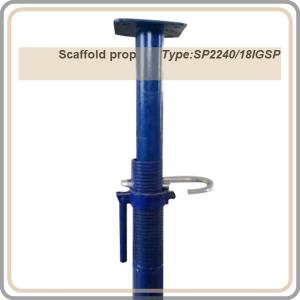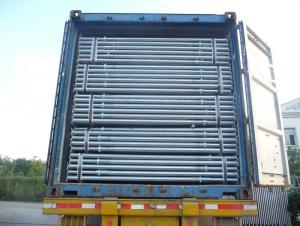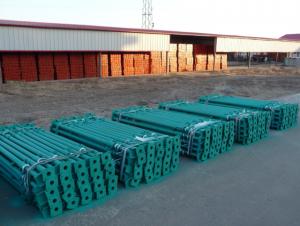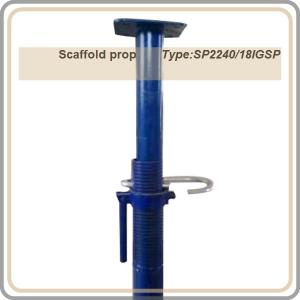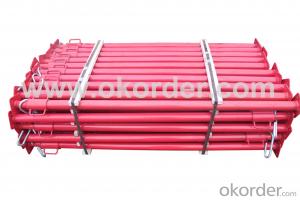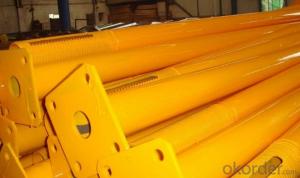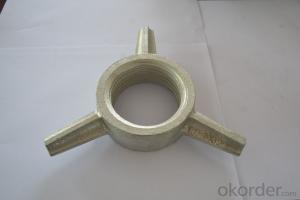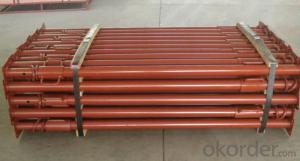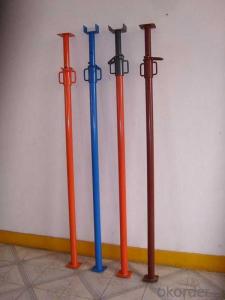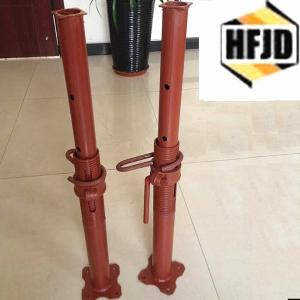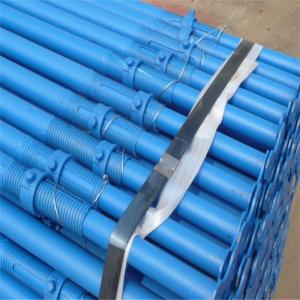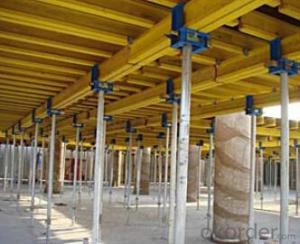Export Scaffold props /painted surface steel prop / telescopic steel prop / blue color prop 2.2-4M
- Loading Port:
- China Main Port
- Payment Terms:
- TT or LC
- Min Order Qty:
- 1680 Piece/Pieces 1680pcs / 20'FT container pc
- Supply Capability:
- 10000 pc/month
OKorder Service Pledge
OKorder Financial Service
You Might Also Like
1. Length 2200-4000mm
2. Outer tube diameter 56mm
3. Inner tube diameter 48mm
4. Tube material : Q235
5. Tube thickness : 1.8mm
6. weight : 10kgs
7. square plate : 120*120*4mm
8. Italian type nut
9. G-pin 12
10. Painted surface
11. Color : as customer 's request . red / blue / green / orange/ brown
Packaging & Delivery
| Packaging Details: | packaging :50pcs / bale container : 1680pcs / 20ft |
|---|---|
| Delivery Detail: | 20-30days after receive deposit |
Specifications
Adjustable props / construction prop
Height 2.2-4M
Italy type painted props
Adjustable props
Shoring props
Construction scaffold steel prop
Scaffold props
Telescopic steel props
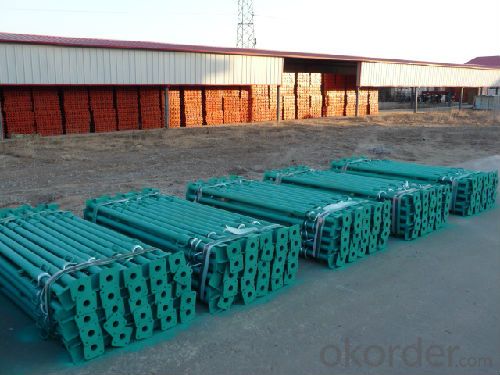
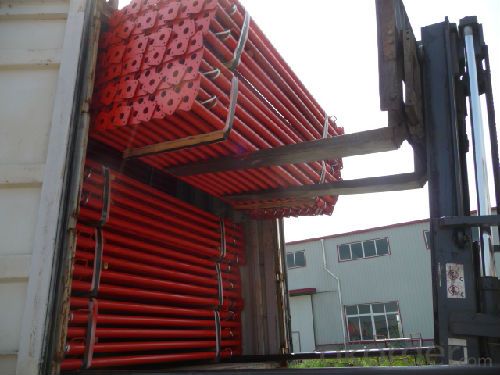
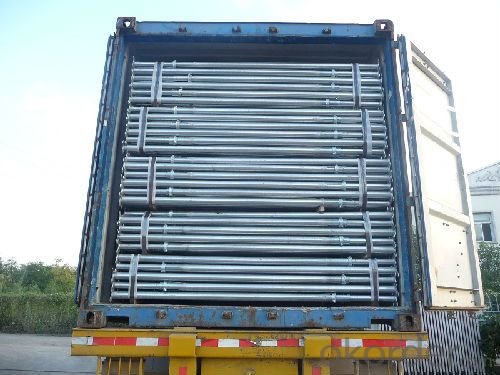
Product introduce
Steel Prop is a labour and time saving device to support shuttering and centering.
It is made outer tube of 60mm (O. D.) & inner pipe of 48mm (O. D.)
or outer tube 56mm (O.D.) & inner pipe 48mm (O.D.) ,
or outer tube 48mm (O.D.) & inner pipe 40 mm (O.D.) moving in each other telescopically.
The surface has painted , powder , electric galvanized and hot dipped galvanized .
The height use of props by double staging is recommended upto 7000mm only .
Top and bottom plate are provided with nail holes for wooden beam or steel beam .
The top has square shape , flower shape or U-head , U-fork head .
U-head can use fix or adjustable .
- Q:Are steel props resistant to corrosion and rust?
- Indeed, resistance to corrosion and rust is a characteristic commonly associated with steel props. Steel, an alloy mainly consisting of iron and carbon, is renowned for its robustness and endurance. Nevertheless, steel can still undergo corrosion and rust in specific circumstances, such as when exposed to moisture, chemicals, or extreme temperatures. In order to augment the steel props' ability to withstand corrosion, they are frequently subjected to protective coatings or galvanization. These coatings serve as a barrier, obstructing the access of water and oxygen to the steel surface, thus hindering the onset of corrosion. Additionally, regular maintenance and inspection are crucial to ensure the continual resilience against corrosion and rust.
- Q:Are steel props suitable for use in underground utility tunnel construction?
- Yes, steel props are suitable for use in underground utility tunnel construction. Steel props, also known as steel shoring or steel supports, are commonly used in construction projects to provide temporary support to structures or excavations. They are designed to withstand heavy loads and provide stability in various applications, including underground tunnels. Steel props offer several advantages for use in underground utility tunnel construction. Firstly, they are strong and durable, capable of supporting the weight of the tunnel and any additional loads such as utilities or equipment. They can be adjusted to different heights and lengths, allowing for flexibility in the construction process. Additionally, steel props are easy to install and remove, making them ideal for temporary applications. They can be quickly assembled and disassembled, which helps to reduce construction time and costs. Moreover, steel props can be reused in other projects, making them a cost-effective solution in the long run. In terms of safety, steel props provide a stable and secure support system for workers and equipment during tunnel construction. They are designed to withstand lateral forces and minimize the risk of collapse or accidents. This ensures the safety of workers and helps to prevent potential damage to the tunnel or utilities. Overall, steel props are a suitable choice for use in underground utility tunnel construction. They offer strength, durability, flexibility, and safety, making them an effective solution for supporting the excavation and construction of tunnels.
- Q:Can steel props be used for supporting temporary structures during disaster relief efforts?
- Yes, steel props can be used for supporting temporary structures during disaster relief efforts. Steel props provide sturdy and reliable support, making them suitable for holding up temporary structures such as tents, shelters, or makeshift medical facilities in disaster-stricken areas. The strength and durability of steel make it a preferred choice for ensuring the stability and safety of structures in challenging environments.
- Q:Do steel props comply with building regulations?
- Yes, steel props comply with building regulations. Steel props, also known as adjustable steel props or acrow props, are commonly used in the construction industry to support temporary structures, such as scaffolding, formwork, and shoring systems. These props are designed and manufactured to meet specific load-bearing requirements and safety standards set by building regulations. Building regulations vary by country and region, but they generally include guidelines and standards for structural stability, load-bearing capacity, and safety. Steel props are typically made from high-grade steel and are designed to withstand heavy loads and provide stability to the temporary structures they support. In many countries, building regulations require that temporary structures meet specific criteria, such as having the required load-bearing capacity, stability, and being properly installed by trained professionals. Steel props are often tested and certified to ensure compliance with these regulations. Before using steel props, it is important to consult with building authorities or qualified engineers to ensure compliance with local building regulations and obtain any necessary permits or approvals. Additionally, it is crucial to follow the manufacturer's instructions for proper installation, use, and maintenance of steel props to ensure they remain compliant with building regulations throughout their lifespan. In summary, steel props are designed and manufactured to comply with building regulations. However, it is important to consult with local building authorities and follow the manufacturer's instructions to ensure compliance with specific regulations and best practices in your area.
- Q:Can steel props be used for supporting temporary seating arrangements or bleachers?
- Yes, steel props can be used for supporting temporary seating arrangements or bleachers. Steel props, also known as adjustable steel props or steel acrow props, are designed to provide temporary support and stability to various structures during construction or renovation work. They are commonly used in the construction industry to support formwork, scaffolding, and temporary structures. When it comes to temporary seating arrangements or bleachers, steel props can be an excellent choice for providing the necessary support. Their adjustable height feature allows for customization and ensures that the seating arrangements are at the desired level and angle. Steel props are made from high-quality steel, which provides durability and strength to withstand the weight and pressure exerted by the seating arrangements or bleachers. Additionally, steel props have a wide base and a load-bearing capacity that can be adjusted according to the specific requirements of the seating arrangements or bleachers. This makes them suitable for supporting different sizes and weights of temporary structures. The stability and sturdiness of steel props ensure the safety of the occupants and minimize the risk of accidents or collapses during events or gatherings. In conclusion, steel props are an ideal choice for supporting temporary seating arrangements or bleachers. Their adjustable height, durability, and load-bearing capacity make them reliable and efficient in providing the necessary support and stability for such structures.
- Q:Can steel props be used in underground construction projects?
- Yes, steel props can be used in underground construction projects. Steel props provide strong support and stability, making them suitable for various applications in underground construction such as tunneling, mining, and excavation. They can effectively withstand heavy loads and ensure the safety and structural integrity of the underground structures.
- Q:Can steel props be used in temporary support of conveyor systems?
- Yes, steel props can be used in the temporary support of conveyor systems. Steel props are strong and durable, making them suitable for providing temporary support to conveyor systems. They can be easily adjusted and set up to the required height and can withstand heavy loads and vibrations caused by the conveyor system. Additionally, steel props can be securely fastened to the ground or other structures, ensuring stability and preventing any movement or displacement of the conveyor system during operation. Overall, steel props are a reliable and practical choice for temporary support of conveyor systems.
- Q:What is the typical weight of a steel prop?
- The typical weight of a steel prop can vary depending on its size and specific design. However, a standard steel prop used in construction projects typically weighs between 20 to 40 pounds.
- Q:What are the design considerations for using steel props?
- When considering the use of steel props in a design, several important factors need to be taken into account. These considerations include the load capacity, adjustability, stability, safety, and ease of installation and removal. One of the primary design considerations for steel props is their load capacity. The props must be able to support the weight of the structure or load they are intended to support. This requires careful calculation and evaluation of the expected load, taking into account variables such as the type of structure, the materials used, and any additional forces or stresses that may be placed on the props. Adjustability is another crucial consideration. Steel props should be easily adjustable to accommodate different heights and provide flexibility during construction or renovation projects. The ability to extend or retract the props allows for precise positioning and support, ensuring stability and accuracy in the construction process. Stability is a critical consideration when using steel props, as they need to provide a secure and stable support system. The design should incorporate features such as a wide base or additional bracing to prevent any potential movement or collapse. This is especially important in situations where the props are supporting heavy loads or are subject to external forces, such as wind or vibrations. Safety is a paramount consideration in any design involving steel props. The design should prioritize the safety of workers and others on the construction site by minimizing the risk of accidents or injuries. This may involve incorporating safety features such as non-slip surfaces, secure locking mechanisms, or visual indicators to ensure proper installation and usage. Finally, ease of installation and removal is an important consideration to facilitate efficient and cost-effective construction processes. The design should allow for quick and easy assembly and disassembly of the props, reducing labor and time requirements. This can be achieved through features such as lightweight materials, user-friendly mechanisms, and intuitive instructions. In conclusion, when designing with steel props, it is crucial to consider factors such as load capacity, adjustability, stability, safety, and ease of installation and removal. By carefully addressing these considerations, engineers and designers can ensure the effective and safe use of steel props in construction projects.
- Q:What are the typical load testing procedures for steel props?
- The load testing procedures for steel props typically encompass the following stages: 1. Initial inspection: Before commencing load testing, it is essential to conduct a thorough examination of the steel props to detect any signs of damage or wear. This entails inspecting for cracks, deformations, corrosion, and other structural issues that may jeopardize the props' integrity. 2. Load calculation: The load testing procedure initiates with the determination of the maximum load capacity that the steel props are designed to withstand. This calculation considers variables such as prop type, dimensions, material strength, and relevant safety codes or standards. 3. Test setup: Once the load calculation is finalized, the subsequent step involves arranging the testing environment. This necessitates securely positioning the props and ensuring proper support to prevent any inadvertent collapse or movement during the test. 4. Load application: Hydraulic jacks, weights, or other suitable equipment are employed to gradually apply load to the steel props. The load is incrementally increased until it reaches the predetermined maximum load specified in the load calculation. 5. Load measurement: Throughout the testing process, precise load measurements are taken at regular intervals to monitor the behavior of the steel props. This encompasses measuring the load distribution across the props and any deflection or displacement that may transpire. 6. Testing duration: Typically, the load is maintained for a specific duration to allow for observation and assessment of the props' performance under sustained load conditions. The duration may vary depending on the specific requirements and standards applicable to the props being tested. 7. Result assessment: Upon completion of the load testing, the collected data and observations are analyzed to evaluate the performance of the steel props. This entails assessing factors such as deflection, stability, and structural integrity, as well as comparing the test results against applicable safety standards or regulations. 8. Report generation: A comprehensive report is usually prepared, documenting the load testing procedures, results, and any relevant observations or recommendations. This report serves as a record of the testing process and provides valuable information for decision-making concerning the use and safety of the steel props.
1. Manufacturer Overview |
|
|---|---|
| Location | |
| Year Established | |
| Annual Output Value | |
| Main Markets | |
| Company Certifications | |
2. Manufacturer Certificates |
|
|---|---|
| a) Certification Name | |
| Range | |
| Reference | |
| Validity Period | |
3. Manufacturer Capability |
|
|---|---|
| a)Trade Capacity | |
| Nearest Port | |
| Export Percentage | |
| No.of Employees in Trade Department | |
| Language Spoken: | |
| b)Factory Information | |
| Factory Size: | |
| No. of Production Lines | |
| Contract Manufacturing | |
| Product Price Range | |
Send your message to us
Export Scaffold props /painted surface steel prop / telescopic steel prop / blue color prop 2.2-4M
- Loading Port:
- China Main Port
- Payment Terms:
- TT or LC
- Min Order Qty:
- 1680 Piece/Pieces 1680pcs / 20'FT container pc
- Supply Capability:
- 10000 pc/month
OKorder Service Pledge
OKorder Financial Service
Similar products
New products
Hot products
Related keywords
